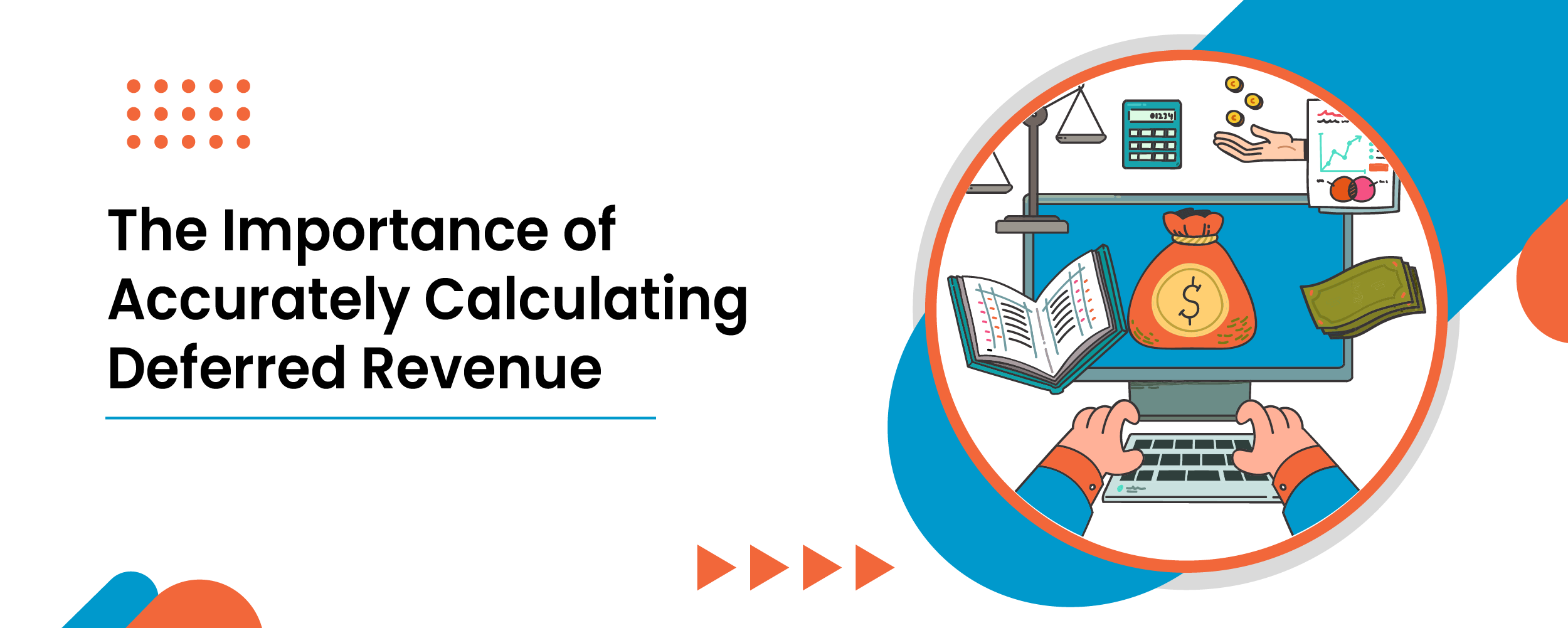The Importance of Accurately Calculating Deferred Revenue
Contributors:
Amol Ghemud
Published: January 5, 2023

Summary
The role of deferred revenue cannot be undermined. Learn how it represents prepayments received for goods or services to be provided in the future. It outlines the calculation process, its significance in financial reporting, and its impact on understanding a company’s financial health. Deferred revenue, seen as a liability, requires careful management to ensure accurate financial statements and operational planning.
Introduction to Deferred Revenue
Every company or business looks forward to earning revenue to grow its financial health. Companies require a consistent flow of revenue to manage expenditures, pay vendors, or even make capital investments. An intangible income may result in a misleading company image, and this is where ‘Deferred Revenue’ comes into the picture.
The Value of current bills over recognizable revenue, as determined by a customer contract, is added and provided in summary form to resolve deferred revenue. Deferred revenue calculation is always determined at a specific point in time because it is a balance sheet item.
Deferred revenue, also known as unearned revenue, is the advanced payments acquired by the company in return for the goods and services it will provide in the future. The prepayment that a company receives reflects the amount on its balance sheet as deferred amount or deferred revenue.
Companies and businesses offering subscription-based services usually ask for prepayments. Deferred revenue is a liability since it is non-earned income (goods and services are provided over time). Examples of deferred services include taxes, payment for a service, deposit for future services, legal fees, advance rent, advance insurance, ticket selling, etc. A company records a current liability if the products and services it delivers are within 12 months. If the period exceeds 12 months, the company records it as a non-current liability.
Deferred revenue calculation is one of the simple calculations. The total of all client deposits, retainers, and other advance payments makes up this amount. Any further deposits and advance payments are added to the deferred revenue amounts, and any revenue received during the accounting period is subtracted from the deferred revenue amounts.
Why is ‘Deferred Revenue’ significant?
Deferred Value is essential to accurately report the liabilities and assets on a balance sheet. The company avoids reporting unearned income in the asset by saying referred revenue specifically on the liability side of the balance sheet.
The referred amount is essential as it lets the company be aware of the amount it owns. There is no doubt that cash is the safest asset for the company. However, cash earned from the deferred revenue remains unearned unless the company delivers the services and products on time.
Deferred revenue relieves the burden of asking for a loan and holds high significance for the company or business as they finance operations.
There are chances where customers may delay their payments due to some reasons, which impacts the company’s overall financial performance. Reporting revenue as and when the company earns helps companies gain a stable income in the long run.
How to calculate Deferred Value?
It is essential to understand how to calculate Deferred revenue value. The referred amount can be called the sum paid as retainers, customer deposits, and other advanced payments. An increased referred amount means an increase in advanced fees and additional deposits. A decrease in the directed amount defines a reduction in revenue earned during the accounting period.
Examples of ‘Deferred Revenue
- One example of deferred revenue is online retailers. They charge the customers through online, debit, or card payments before shipping their orders.
- The automobile industry takes deposits on cars for car dealerships several weeks and months before the delivery.
- A start-up company takes the pre-order to pay for its first manufacturing run of orders.
- Newspapers and magazine publishers ask for advance payments from their customers in return for the annual services they’ll provide throughout the year.
- Phone companies ask for advance payment in return for their pre-paid services.
- One of the forms of referred income is the monthly insurance premiums.
Limitations of Unearned Revenue
Some companies tend to combine the unearned revenue with the actual revenue, which is a liability, and this can result in false profitability numbers with a wrong idea of growth.
In high demand, a business or company may find it challenging to deliver the products and services on time, even after receiving prepayments.
After receiving a prepayment, it is essential on the company’s side to deliver quality products and services at the specified time. If the quality of the service is compromised, it may result in losing customers, thereby degrading a company’s growth.
Wrapping up
Deferred Value is significant for precisely reporting the liabilities and assets on a company’s balance sheet. It is critical to avoid misreporting assets and liabilities. Companies are expected to provide suitable goods and services in return for the prepayments. When the company uses the revenue appropriately, the overall growth of the company is improved, and the finances are all managed and covered.
FAQs
What is the formula for calculating deferred revenue?
Deferred Value can be stated as the Value of invoices minus the recognized Value.
Deferred Value = The value of invoices – Recognised Value
This is the basic deferred value formula. However, this formula may differ for different businesses depending on their business models.
What is total deferred revenue?
The total deferred revenue is the total amount a company receives beforehand in return for the goods and services it will offer in the future. Other terms that signify deferred revenue are unearned, unearned, or deferred.
What is deferred revenue?
Unearned income, deferred revenue, is the term used to describe advance payments a business receives for goods or services that will be provided or rendered. The company that receives the prepayment adds the sum to its balance sheet as deferred revenue, a liability.
Because it represents money promised to customers but has yet to be received, deferred revenue is a liability. The product or service is proportionally recognized as revenue on the income statement as it is supplied over time.
How is deferred revenue calculated?
Deferred revenue is determined by aggregating and reporting, in summary, from the Value of invoices to date over recognizable payments according to client contracts. Deferred revenue is always determined at a specific point because it is a balance sheet item.
Why is deferred revenue important?
Deferred revenue is significant because: Accurately recording assets and liabilities on a balance sheet is essential. Deferred revenue is recorded as a liability rather than an asset on the balance sheet, saving the company from having to report unearned income. It avoids overestimating the company’s net worth as a result.
What are some limitations of using deferred revenue as a metric?
– Deferred revenue may have an impact on a company’s financial situation.
Many businesses combine delayed income and actual revenue. Since delayed revenue is a liability, doing so can have unfavorable effects. Customers might request a refund, as was previously noted, or other unanticipated events might make it challenging to provide the promised services.
Actual revenue and deferred revenue together give the impression of profitability and growth. This may give investors and management a false impression of the company’s financial situation. This might ultimately spell ruin for the business.
-The Business Owes a Duty to the Client
When a business accepts advance payment for a service, it enters into a contractual agreement with the client. As a result, the company must consistently deliver the promised service or goods.
The business must repay the customer and risk losing their faith if it fails to do so if the quality is below par. This duty to the customer may lead to difficulties.
-The Business Might Not Be Able to Meet the Demand
The deferred revenue line might increase more quickly than the company. A company could receive excessive orders that have already been paid for.
Customers will be satisfied if the company can meet demand. This can result in a loss of income.
How can a company use deferred revenue to make strategic decisions?
Payments a business receives for goods or services that have yet to be delivered or provided are referred to as deferred revenue. Until the related products or services are offered, this revenue is listed as a liability on the balance sheet.
By examining the kind and volume of deferred revenue, a business can use it to inform its strategic choices. For instance, a company may be significantly dependent on long-term contracts or subscription-based business models if a sizable amount of its revenue is postponed. The corporation can use this data to inform its pricing, marketing, and product development decisions.
Deferred revenue can also show a company’s working capital and cash flow management. A business may have extra cash if it has much-deferred income to put towards expansion plans or utilize to pay off debt. In contrast, a company may need to look into financing solutions if it has a small amount of delayed income to finance its operations.
In general, a firm can learn important things about its business model, cash flow, and financial health by examining deferred revenue, which can help it make strategic decisions.
Other Startup KPI Metrics
Understanding and Maximizing Monthly Recurring Revenue
The ARR Advantage for Startups: Understanding and Calculating Annual Recurring Revenue
Using ACV to Measure the Success of Your Sales and Marketing Efforts
Total Contract Value – A Key Metric for Evaluating Business Performance
Why Customer Lifetime Value Is the Most Crucial Metric for Your Business
Maximizing User Retention: How to Calculate Daily Active Users
Compounded Monthly Growth Rate: Understanding and Calculating Compounded Monthly Growth Rates
Calculating Your Company’s Total Addressable Market (TAM): A Step-by-Step Guide
Measuring Monthly Recurring Revenue: Expert Tips and Advice
Maximizing the Efficiency of Your Billing Process in Accounting
About the Author
Optimizer in Chief
Amol has helped catalyse business growth with his strategic & data-driven methodologies. With a decade of experience in the field of marketing, he has donned multiple hats, from channel optimization, data analytics and creative brand positioning to growth engineering and sales.
 Growth Strategy and Planning
Growth Strategy and Planning Inbound Growth
Inbound Growth Growth Hacking
Growth Hacking Search Engine Optimization
Search Engine Optimization Paid and Performance Marketing
Paid and Performance Marketing Social Media Marketing
Social Media Marketing AI-Driven Growth Strategy
AI-Driven Growth Strategy
 Growth Tools
Growth Tools Offers
Offers






















Leave a Reply